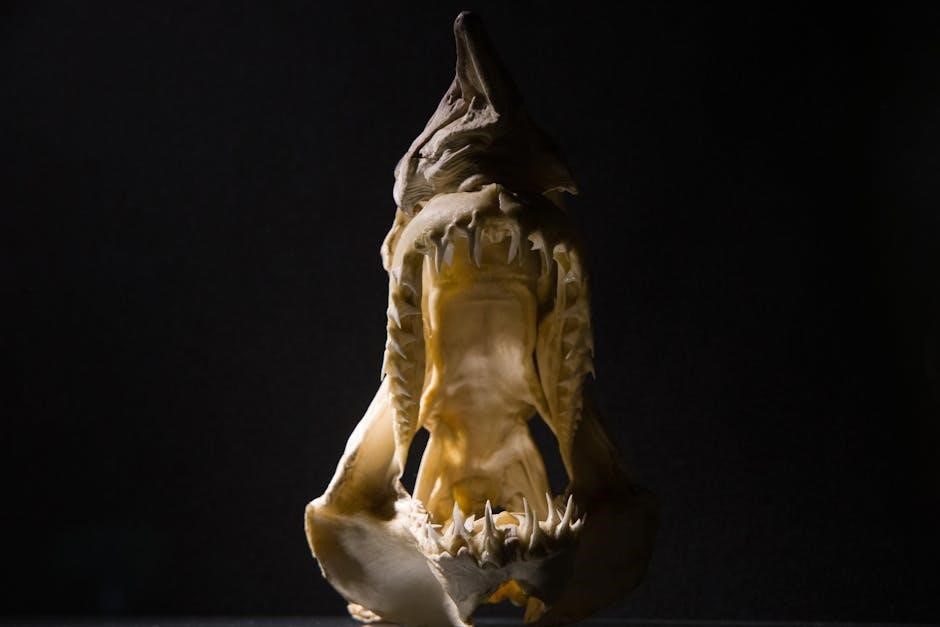Discovering shark teeth is exciting, with guides like Lets Go Fossil Shark Tooth Hunting available on Amazon, helping identify and find fossilized teeth, using the lingual view for accurate identification methods.
Overview of Shark Teeth Identification
Shark teeth identification involves examining the tooth’s characteristics, such as shape, size, and serrations. The lingual view, which shows the side of the tooth facing the mouth, is crucial for accurate identification. By comparing the tooth’s features to reference images or guides, collectors can determine the species and type of shark. Online resources, like forums and identification guides, provide valuable information and expertise to help collectors identify their finds.

Shark Tooth Hunting Locations
Beaches like Holden Beach are popular spots for shark tooth hunting with abundant fossil finds and exciting discoveries waiting to be made every day naturally.
Popular Locations for Finding Shark Teeth
Popular locations for finding shark teeth include beaches with shallow waters and gentle slopes, such as Holden Beach, where fossilized teeth can be found after storms or rough seas.
These locations are often characterized by their unique geology, with exposed sedimentary rocks that contain fossilized remains of ancient sharks.
The presence of these fossils is a testament to the region’s rich marine history, with many species of sharks having lived and died in the area over millions of years.
As a result, beaches like Holden Beach have become popular destinations for fossil hunters and collectors, who come to search for rare and well-preserved shark teeth.
With the right tools and knowledge, anyone can join the hunt and discover the fascinating world of shark teeth fossils, learning about the different species and their characteristics, and maybe even finding a rare specimen;
The search for shark teeth is a fun and rewarding experience that can be enjoyed by people of all ages, and with the many popular locations available, it’s easy to get started.

Shark Tooth Identification Methods
Experts use various methods, including viewing teeth from different angles, to accurately identify species and characteristics of shark teeth fossils, using online guides and resources.
Using the Lingual View for Identification
The lingual view is a crucial aspect of shark tooth identification, as it provides a clear view of the tooth’s internal structure. By examining the lingual view, experts can determine the species of shark and other characteristics of the tooth. The lingual view is the side of the tooth that faces the inside of the mouth, and it is often used in conjunction with other views to make a positive identification. Many online guides and resources, such as the book “Lets Go Fossil Shark Tooth Hunting”, provide detailed information on how to use the lingual view for identification. Additionally, experts often post images of shark teeth next to a reference object, such as a quarter, to help illustrate the size and shape of the tooth. By using the lingual view and other identification methods, enthusiasts can accurately identify their finds and learn more about these fascinating fossils.

Types of Shark Teeth
Shark teeth include Otodus species, Sand Tiger, and Lemon, each with unique characteristics and features, found in various locations and formations, requiring expertise for accurate identification and classification methods.
Characteristics of Otodus Species Teeth
Otodus species teeth have distinct characteristics, including large size and coarse serrations, with some species like Otodus megalodon and Otodus chubutensis being particularly notable for their massive size and triangular shape.
The teeth of Otodus species are often found in fossil form, providing valuable insights into the evolution and diversity of ancient sharks.
These teeth can be identified by their unique morphology, including the presence of a distinctive root and a serrated blade, with the lingual view being particularly useful for identification purposes.
The characteristics of Otodus species teeth make them highly prized among fossil collectors and shark enthusiasts, with many seeking to add these impressive fossils to their collections.
Overall, the study of Otodus species teeth offers a fascinating glimpse into the world of ancient sharks, and continues to be an active area of research and discovery, with new finds and identification methods being developed all the time, helping to shed more light on these magnificent creatures.

Shark Tooth Sizing and Measurement
Measuring shark teeth involves comparing them to reference objects, like quarters, to determine size and authenticity accurately always.
Using Reference Objects for Size Comparison
When it comes to sizing shark teeth, using reference objects is a common practice. Many collectors and enthusiasts use everyday objects, such as coins, to compare the size of their finds. For instance, a quarter is often used as a reference point, allowing collectors to quickly determine the size of a tooth. This method is particularly useful when sharing finds online, as it provides a standardized point of reference. By placing a tooth next to a quarter, collectors can easily convey the size of their find to others. This technique is also helpful when trying to identify the type of shark tooth, as certain species are known to have teeth of specific sizes. Using reference objects, such as a quarter, can help collectors to better understand the characteristics of their finds and make more accurate identifications. This simple yet effective method is widely used in the shark tooth collecting community.
Shark Tooth Identification Resources
Guides like Lets Go Fossil Shark Tooth Hunting on Amazon provide valuable resources for identification and finding fossilized teeth effectively online every day.
Recommended Guides for Shark Tooth Identification
There are several guides available for shark tooth identification, including books and online resources. One recommended guide is Lets Go Fossil Shark Tooth Hunting, available on Amazon, which provides a comprehensive overview of shark tooth identification and hunting. This guide is suitable for both children and adults, and includes information on the different types of shark teeth, as well as tips and techniques for finding and identifying them. Additionally, there are many online forums and communities dedicated to shark tooth hunting and identification, where enthusiasts can share their knowledge and experiences. These resources can be very helpful for those looking to learn more about shark tooth identification and to improve their skills. By using these guides and resources, individuals can become more confident and accurate in their ability to identify shark teeth. Overall, having access to these guides and resources can enhance the experience of shark tooth hunting.
